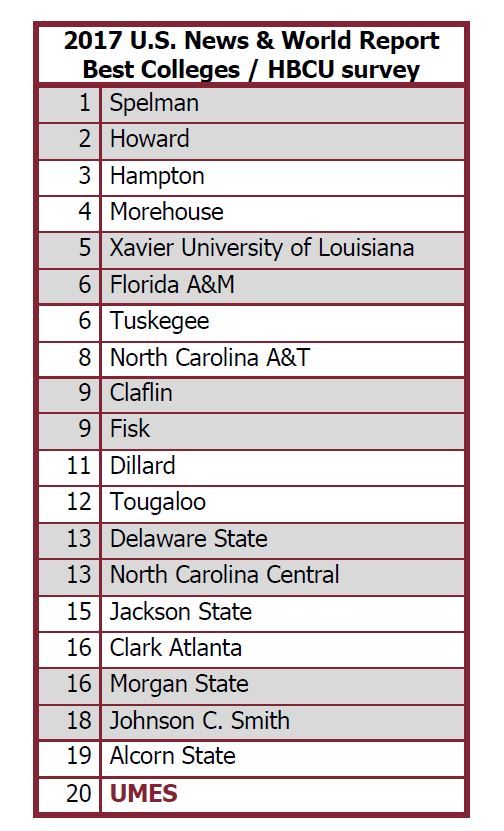
Monday, September 11, 2017
The University of Maryland Eastern Shore moved up to the nation’s Top 20 historically black institutions, according to the latest edition of U.S. News & World Report’s annual Best Colleges survey released today.
At number 20, UMES’ ranking is its highest since the news magazine undertook a peer-review survey 11 years ago exclusively focusing on historically black colleges and universities.
“I am delighted at our recognition as one of the nation’s top HBCUs,” UMES President Juliette B. Bell said. “As we celebrate the 131st anniversary of our founding on Sept. 13, 1886, we are proud of the rich history and legacy that we continue to build upon as we move From Excellence to Eminence.”
“The ranking reflects the hard work and dedication of our faculty, staff, and students. We are all committed to making UMES greater than ever. ” Bell said.
“On behalf of the Board of Visitors, I would like to congratulate everyone associated with receiving this ranking. I have an up-close perspective on how hard everyone at UMES works at doing their jobs – students, faculty and staff,” board Chairman John Allen said. “This year’s survey unquestionably reflects that efforts.”
UMES now awards at least 20 research doctorates annually, which in 2016 earned it a Doctoral University (Moderate Research Activity) designation from the widely respected Carnegie Classification of Institutions of Higher Education. The university is one of three public institutions in Maryland with that sought-after distinction.

Since the last survey, two UMES professors have secured a U.S. Patent, one in engineering and the other in pharmaceutical sciences, both professional achievements that underscore the university’s commitment to science, technology, engineering and mathematics, collectively known as the “STEM” disciplines.
Undergraduates who earned STEM degrees this past spring had accepted job offers from such employers as Cisco and Raytheon, both Fortune 500 companies, as well as Orbital ATK, an aerospace manufacturer and defense industry company.
The past three classes of graduate students who earned Doctorates in Physical Therapy have all achieved a 100 percent pass rate on the first attempt taking a national licensure exam required to practice.
The university’s newest ranking is two spots higher than a year ago. UMES is one of eight public institutions to make this year’s Top 20 HBCUs.
U.S. News & World Report rated Spelman College, a private institution in Atlanta, as the nation’s best HBCU. Seventy-three institutions were listed in the latest survey.
Of the 73 HBCUs ranked in the 2017 survey, only 16 received a higher “peer assessment” score than UMES, a leading factor in the publication’s ranking equation.
U.S. News asks senior administrators – presidents, academic policymakers and admissions directors – to rate the academic quality of peer institutions. Graduation and retention rates, and faculty resources also carry a lot of weight in the ranking equation.
Other factors taken into consideration include the number of full-time faculty, student selectivity based on test scores and high school class standing, the institution’s financial resources and how large classes are. UMES’ student-to-faculty ratio is 14-to-1, and 56 percent of classes the university offers average fewer than 20 students.
UMES offers 37 undergraduate majors, 15 master’s degrees and eight doctoral programs. Twenty-six academic units hold specialized accreditations, including four that achieved reaccreditation in the past year; business management and accounting, hospitality and tourism management, pharmacy and rehabilitation counseling.
U.S News describes HBCUs as “an appealing option for applicants of all races.” One-third of UMES’ student body was non-African American during the latest survey period, according to the university’s institutional research office.
The Middle States Commission on Higher Education reaffirmed UMES’ institution-wide accreditation in 2016 for the maximum eight-year period.

